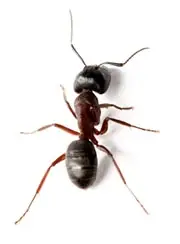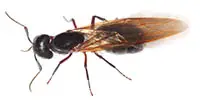
This picture is typical of the appearance of a Carpenter Ant. While there are over a thousand species of carpenter ants worldwide, only about 12 to 14 types exist in the US. Carpenter ants are arguably the largest in the country ranging in size from about 1/4″ to 1″ long depending upon type, gender, age and role of each carpenter ant in its caste system.
Color of Carpenter Ants
The color of carpenter ants are slightly different depending upon specific type. Although species exist in all states, a particular species will be more dominate in certain regions of the country. Colorization can range from almost solid black to combinations of color dominant in black and dark brown with shades of lighter brown, red and yellow. A carpenter ant can have a black body with a reddish thorax.
Size of Carpenter Ants

Colonies of carpenter ants exist in a caste system where each member of the colony has a defined role and that role also has an affect on size. Each colony has a queen and along with winged females, they are the largest reaching a length of about 1 inch long.
The vast majority of other carpenter ants are “workers”. Workers are divided into minor and major sizes which define their specific roles. Typically, workers range from 3/16′ to about 1/2″ depending upon the species. Some species are larger while others are smaller. The largest species in America are Black Carpenter Ants which are most common in the Eastern and Western states.
Smaller (minor) workers take care of the young and forage for food. The larger workers (major) assume the role of “soldiers” to protect the nest and defend against predators. All worker carpenter ants are genetically female but sterile and do not reproduce. Winged males are a bit larger than workers and their primary responsibility is mating and die shortly fertilization.
Carpenter Ant Physical Characteristics
All carpenter ants physically look the same except for slight differences in color and size. When viewed from the side, the ants have an evenly rounded thorax. The body has three distinct segments including head, thorax and abdomen with a very thin waist with a single node at the front of the abdomen. They pretty much look like all ants with minor differentiating characteristics. Any black ants of 3/8″ or longer are most likely carpenter ants.
Winged carpenter ants are often confused with termites. You can tell the difference as follows:
Winged Carpenter Ants:
- Elbowed antennae
- 3 Distinct body segments with a slim waist
- Front wings are longer than back ones
- 3/8 inches and longer
Winged Termites:
- Straight antennae
- No waistline
- Longer wings of equal length
- Usually only about 1/8″ long
Careful observation of carpenter ants is vital in safeguarding your home from potential damage. By recognising their distinct physical features, behavior patterns, and nesting sites you can take early and effective measures against potential carpenter ant infestations. Remember to seek professional assistance as soon as you suspect an infestation if any pest-related concerns arise; at Pest Therapy of McKinney we specialize in comprehensive pest management solutions designed to protect both property and peace of mind.
Pest Therapy’s experienced team can provide tailored strategies tailored specifically to your individual needs. Take action now to guarantee a pest-free future – contact Pest Therapy now for reliable assistance in keeping a home pest-free.
